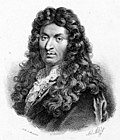Jean-Baptiste Lully
Jean-Baptiste Lully (pronounce: "Loo-lee"), (born Florence, 28 November 1632; died Paris, 22 March 1687), was an Italian composer, violinist and dancer who spent most of his life working in the court of Louis XIV of France. He took on French nationality in 1661. He was the most important French composer of his time. Lully realized that music in the Italian style was not suitable for the French language, so he composed his operas in a special way. He created the tradition of French opera. He also wrote a lot of ballet music and some church music.
Jean-Baptiste Lully | |
|---|---|
 | |
| Born | 28 November 1632 |
| Died | 22 March 1687 |
| Occupation | Composer |
Life
Lully was born in Florence, Italy. Lully did not have much education. He taught himself a lot of what he could do. He learned to play the guitar and the violin and to dance.
In 1646 he was taken to France where he was given a job teaching Italian to a Duchess. He had the opportunity to hear a lot of good music, and, by the time he was 20, he was an excellent composer, violinist and dancer.
He started to work for Louis XIV in 1652. He composed some music for the Ballet de la Nuit (Night Ballet). The king liked it very much. He became composer of instrumental music to the king. His orchestra (called Grande Bande, i.e. large band) had 24 violins. They were not very good, so he got the king’s permission to start another group which he called Petits Violons (Little Violins). There were 16 in the group (later it became 21), and Lully trained them properly. He did not let them put too many ornaments in the music.
He became a Frenchman in 1661. The next year he became Music Master to the Royal Family and he also married. The king and queen signed the marriage document, so Lully was obviously an important man.
Lully composed lots of ballets for the King during the 1650s and 1660s. He was one of the dancers in these ballets. The king also danced. He worked with the great playwright Molière, composing music for Molière’s comedies. These include Le Mariage forcé (1664), L'Amour médecin (1665), and Le Bourgeois gentilhomme (1670). Together with Molière he created the Comédie-Ballet which became a great French tradition.
When the king got older he could not dance and so he became less interested in ballet. So Lully became more interested in composing operas. He earned a lot of money from this, because there was an arrangement with the king that Lully would have complete control of any music that was published in France. Lully had become a very powerful man, and many other musicians did not like this. There were a lot of arguments, especially when Lully did not allow music in puppet shows.
Lully had lots of successes in his life. He also had many love affairs, with men and women. There were several scandals, but the king always forgave him because he was a great friend.[1] · [2] · .[3]
Death
Late in 1686 the king had been ill, but he got better, so he asked Lully to organize a concert to celebrate the fact that he was well again. The concert was given on 8 January 1687. The orchestra played a Te Deum. Lully conducted the orchestra. Conductors did not yet use batons (sticks) in those days. Instead, Lully banged a big stick on the floor to keep the orchestra together. Suddenly, he hit his toe with his stick. The wound in the toe got an infection. The infection later became gangrene. He did not want the doctors to cut off his toe. The infection spread to the rest of the body, and he died on 22 March from gangrene.
Lully was rich when he died. He left 800.000 livres. He had five houses in Paris as well as two country houses.
Music
Lully lived in the middle of the Baroque period. He liked fast, lively music, especially music that could be danced to. He changed people’s taste in musical style. He used a lot of instruments that had not been used in orchestras before. His friendship with Molière resulted in a new musical form, the comédie-ballet which combined theatre, comedy, and ballet.
Lully also created the style of French opera called tragédie en musique or tragédie lyrique. Instead of having his opera music divided into recitatives and arias he often combined the two so that events in the story happened quickly.
Jean-Baptiste Lully Media
Pinckney Marcius-Simons, The Young Lulli, by 1888
Nicolas de Poilly the Younger's painting of Titon du Tillet's French Parnassus, 1723
Portrait of Several Musicians and Artists by François Puget. Traditionally the two main figures have been identified as Lully and the librettist Philippe Quinault. (Louvre)
Jean-Baptiste Lully and Philippe Quinault's opera Alceste being performed in the marble courtyard at the Palace of Versailles, 1674
Portrait of a gentleman, traditionally said to be Jean-Baptiste Lully, by Paul Mignard
References
- ↑ "Lully, Jean-Baptiste (1632-1687) Archived 2007-10-11 at the Wayback Machine" from Glbtq.com, An Encyclopaedia of Gay, Lesbian, Bisexual, Transgender and Queer Culture.
- ↑ (in English) Julie Anne McCornack Sadie, Companion to Baroque Music, p.96.
- ↑ Michael Steen, The Lives and Times of the Great Composers, préface.






